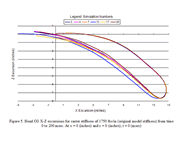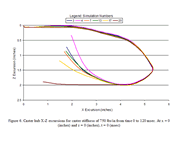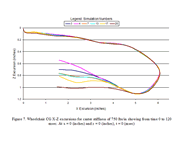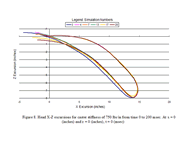Effect of Manual Wheelchair Caster Stiffness and Energy Absorption on Wheelchair-Occupant Kinematics During a Frontal Impact Using Computer Simulation
R. Dsouza, BS1 , G. Bertocci, PhD1 , L. van Roosmalen, PhD2
1 Injury Risk Assessment and Prevention (iRAP) Laboratory, Mechanical Engineering Department, University of Louisville
2 Department of Rehabilitation Science and Technology, University of Pittsburgh
ABSTRACT
Many wheelchair users traveling in motor vehicles are required to or choose to remain seated in their wheelchairs. Studies have shown that casters are particularly prone to failure, if the vehicle were involved in a frontal impact. This study evaluates the use of incorporating energy absorption into the wheelchair casters to improve wheelchair-occupant kinematics. A parametric sensitivity analysis conducted using a previously validated computer crash model suggested that caster stiffnesses between 1750 lb/in and 750 lbs/in, along with R and G factors between 0 - 0.5 and 0.75 - 1, respectively can improve wheelchair-occupant kinematics by dissipating the crash energy. Such an approach may present opportunities to reduce wheelchair-seated occupant injury risk in a motor vehicle crash.
KEYWORDS
Wheelchair Safety, Simulation, Caster Design, Caster Stiffness, Energy Absorption
BACKGROUND
There are approximately 2.3 million wheelchair users in the US [1]. The Americans with Disabilities Act (ADA) [2] has led to an increased number of wheelchair users who are seeking transportation in motor vehicles. Wheelchair users who are unable to transfer to a motor vehicle seat must rely on their wheelchair to provide a safe, stable support surface and occupant protection in the event of a motor vehicle crash.
Unlike OEM (Original Equipment Manufacturer) motor vehicle seats, wheelchairs are not always designed to protect occupants from injury during motor vehicle impact. To provide wheelchair occupants with the same level of safety as other vehicle passengers, wheelchairs must be capable of withstanding dynamic crash level forces. Study findings indicate that wheelchair caster/fork assemblies are often incapable of withstanding the forces associated with crash level loading [3, 4]. Although excessive caster/fork bending or fracture exposes wheelchair-seated individuals to increased risk of injury due to an unstable seating surface; controlled bending or failure of components and associated energy absorption can be advantageous in a crash.
Since the late 1960’s, the automotive industry has been incorporating energy absorption systems [5] in vehicles. The crumple zone in cars was one of the first passive safety features adopted by the automobile industry after the introduction of occupant restraints. The crumple zone or deformation zone is a structural feature that absorbs energy upon impact. Engineers designed weak spots in the car's structure to enable the front or rear-end to collapse in a controlled manner on impact. Energy from the impact is then expended in deforming metal or plastic components, often converting it into heat and sound, thereby reducing the force transferred to the occupants and reducing the risk of injury.
Following a similar approach, it may be possible to achieve this proven method of controlled deceleration in wheelchair design. During a frontal impact vehicle collision (20g), as wheelchair occupants tend to move forward and downward, casters (caster and fork assembly) are subjected to loads as high as 8000 N [6]. This makes the caster an ideal component of the wheelchair that can be redesigned to incorporate energy absorption properties. In this preliminary study, we examined the effects of caster design (stiffness and energy absorbing properties) on wheelchair and occupant kinematics, and identified a design that minimized wheelchair and occupant excursions during frontal impact and rebound, using a validated computer simulation model.
METHODS
A previously validated, rigid body, computer crash simulation model representing the 50th percentile male Hybrid III Anthropomorphic Test Device (ATD), seated in an adult manual wheelchair, subjected to an SAE J2249 compliant 20g/30mph frontal impact pulse [7], developed in Articulated Total Body (Advanced Information Engineering Services, Inc., Dayton, OH 45431), was used to evaluate the effects of varying the properties of the caster on wheelchair and occupant kinematics. The ATD was restrained by a vehicle mounted, 3-point occupant restraint system and the wheelchair was secured by a 4-point, belt-type tiedown system [8].
Using a computer model, a parametric sensitivity analysis was conducted to examine wheelchair and occupant kinematics, based on varying caster properties. The caster used in the model had a 7 inch diameter and a 1.25 inch wheel width. A total of three parameters were varied during this study. Firstly, the caster stiffness which primarily affects the loading portion of the crash event was varied from 2750 lb/in to 250 lbs/in from a baseline stiffness of 1750 lb/in with increments of 500lbs/in, while maintaining all other values constant. Investigation into these simulation results led to the elimination of caster stiffnesses that proved potentially harmful to the wheelchair occupant. Using the original caster stiffness (1750 lbs/in) and the least caster stiffness (750 lbs/in) permissible without causing possible injury to the wheelchair occupant, the two parameters associated with unloading of the caster and rebound of the wheelchair and occupant, were varied as per Table 1. These two variables were the R-factor, and the G-factor.
The R factor is the energy absorption function and is used to specify the amount of energy recovered at the end of unloading. The G factor is the permanent deflection function and is used to model permanent deformation due to contact force. Both R and G values can range from 0 to 1. The equation and graphical depiction of R and G factors are illustrated in Figure 1.
For each simulation performed evaluating the various caster scenarios, the effect on the wheelchair and occupant kinematics were studied. The crash response of the wheelchair was explored by examining the wheelchair CG excursions and caster hub excursions, characterizing the motion of the wheelchair. Wheelchair-occupant response was evaluated by measuring head CG excursions. Excursions in the horizontal plane are represented as x-excursions and excursions in the vertical plane are represented as z-excursions.
| Factor | R=0 | R=0.25 | R=0.5 | R=0.75 | R=1 |
|---|---|---|---|---|---|
| G=0 | X |
X |
X |
X |
X |
| G=0.25 | X |
X |
X |
X |
X |
| G=0.5 | X |
X |
X |
X |
X |
| G=0.75 | X |
X |
X |
X |
X |
| G=1 | X |
X |
X |
X |
X |
RESULTS
Caster Stiffness Analysis
Analysis of the crash simulations for varying caster stiffness scenarios indicated that a caster stiffness greater than the original model [8] stiffness of 1750 lbs/in, made no significant changes to the wheelchair and occupant kinematics. Simulations of softer casters (i.e. stiffness less than 1750 lbs/in) showed that it was possible to change wheelchair/occupant kinematics during a frontal impact. However, caster stiffnesses lower than 750 lbs/in create a scenario that exceeds the geometrical limits of the caster. Such casters would have to be larger than standard sized casters to allow such excessive deflection. Also caster stiffnesses lower than 750 lbs/in create extreme downward and forward pitching of the wheelchair which can be unsafe given an increased risk of occupant lap belt submarining. Lap belt submarining is characterized by the pelvic restraint slipping upward over the iliac crests and loading the soft abdominal tissues. Submarining can lead to severe internal injuries of organs in the abdominal region [9].
The risk of lap belt submarining of occupants in frontal impacts was assessed in a study that established a torso angle injury criterion as measured from the vertical as 30? [10]. Figure 2 shows the torso angle relative to the vertical for different caster stiffnesses. It is evident from the plot that caster stiffness of 250 lbs/in produces a torso angle over 30?, suggesting a risk of lap belt submarining. Caster stiffness of 750lbs/in or more were found to have a low risk of lap belt submarining. Further analysis in our study included the original caster stiffness (1750 lbs/in) and the stiffness with the potential to have maximum deformation (750 lbs/in) without causing possible injury to the wheelchair occupant.
Energy Absorption/Permanent Deformation Analysis
Caster stiffnesses of 1750 lbs/in (original model stiffness) and 750 lbs/in were used to analyze the influence of energy absorption (R) and permanent deflection (G) function to examine wheelchair and occupant kinematics as per Table 1.
Figures 3, 4 and 5 provide caster hub excursions, wheelchair CG excursions and head CG excursions for the stiffness of 1750 lbs/in. Each of the scenarios begins with a forward and downward motion, but differences were observed on rebound and unloading of the caster. Instances occurred where multiple energy absorbing scenarios had an identical response curve. In such cases, one of the trials was used to represent the group with identical responses. Table 2 provides the R and G factor legend for the simulations represented in the plots.
| Simulation No. | R | G |
| 3 | 0.75 | 0 |
| 4 | 1 | 0 |
| 7 | 0.5 | 0.25 |
| 13 | 0.75 | 0.5 |
| 17 | 0.5 | 0.75 |
| 20 | 0 | 1 |
In Figures 3 and 4, the loading function is represented by the curve, until maximum deformation is achieved. Thereafter the unloading function is observed, at the end of which variations in permanent deformation are seen. The instances with maximum permanent deformation show the maximum energy absorption.
Maximum energy absorption is evident in simulation number 20 which has the maximum difference between its initial and final z excursion. This difference between initial and final excursion in the z direction shows permanent deformation. Figure 6, 7 and 8 provides caster hub excursions, wheelchair CG excursions and head CG excursions for the caster stiffness of 750 lbs/in. The excursion of the caster and wheelchair CG in this case shows the additional deformation the caster is experiencing because of its reduced stiffness. Maximum energy absorption is seen in runs 17 and 20.
The parametric sensitivity analysis of the caster energy absorption/permanent deformation for both caster stiffness scenarios revealed that simulation numbers 3, 4, 7 and 13 were least favorable as there was minimal energy absorption. In contrast simulation numbers 17 and 20 were associated with substantial energy absorption which is evident by the unloading curves and permanent caster deformation.
Table 3 shows a summary of the effects of varying caster properties (caster stiffness, R and G factors) on the outcome measures.
| Caster Stiffness (lbs/in) | R factor | G factor | Caster hub peak excursion Z (inches) | Wheelchair CG peak excursion Z (inches) | Head CG peak excursion Z (inches) |
|---|---|---|---|---|---|
1750 |
0 - 1 |
0 - 1 |
-0.41 – 1.01 |
0.365 – 0.737 |
-0.335 – 0.209 |
750 |
0 - 1 |
0 - 1 |
0.34 – 1.88 |
0.542 – 0.99 |
-0.564 – 0.441 |
DISCUSSION & CONCLUSION
The sensitivity analysis indicates that caster stiffness and caster energy absorption characteristics do influence the wheelchair and wheelchair occupant kinematics during a frontal impact. Caster stiffnesses less than 1750 lb/in, with minimal energy absorption properties (simulation number 3) showed increased rearward (negative z-direction) head CG excursion than instances with greater energy absorption properties (simulation numbers 4, 7, 13, 17 and 20), whereas caster stiffnesses more 1750 lb/in had no such correlation. The results show that caster stiffness below the original model [8] stiffness of 1750 lb/in is favorable to improve wheelchair and occupant kinematics, although stiffnesses below 750 lbs/in can cause the risk of lap belt submarining. Also an R factor between 0 and 0.5 with a G factor between 0.75 and 1 can improve overall kinematics by removing energy from the wheelchair and occupant during a frontal impact.
This is the first study that investigates a new method of incorporating energy absorption into wheelchairs as a way to improve occupant kinematics during a frontal impact. As wheelchair casters are exposed to high loads during frontal impacts, this study proposes a method that can effectively reduce the impact energy from a crash by absorbing the energy in a controlled and effective manner. Any reduction in crash energy would translate to a reduced injury potential for the occupant.
Limitations of this study include that it has only considered an adult manual wheelchair with the 50th percentile male occupant. A different wheelchair or different sized occupant could produce different results. Future work will focus on studying the effects of caster stiffness on occupant dynamics by evaluating changes in different injury criteria.
In summary, the results of our study suggest that wheelchair caster designs incorporating energy absorbing features may offer an innovative method of controlling wheelchair and occupant response in a motor vehicle crash. Such an approach may present opportunities to reduce wheelchair-seated occupant injury risk in a motor vehicle crash.
ACKNOWLEDGEMENTS
This study was supported through NIH STTR#1R41HD047105-01. The opinions expressed herein are those of the authors and do not necessarily represent those of the funding agency.
REFERENCES
- LaPlante M, Demographics of Wheeled Mobility Device Users, Space Requirements for Wheeled Mobility Device Users Workshop Proceedings, Center for Inclusive Design and Environmental Access, University of Buffalo, State University of New York, Buffalo, New York, October 2003.
- “Americans with Disabilities Act (ADA) Accessibility Guidelines for Transportation Vehicles”, Architectural and transportation Barriers Compliance Board (ATBCB), 36 CFR Part 1192, Federal Register, Vol. 56, No. 173. September 1991.
- Bertocci G., & VanRoosmalen, L., (2003). Wheelchair Caster Loading During Frontal Impact. Assistive Technology, Vol 15.2, 48 - 55.
- Bertocci, G., Esteireiro, J., Cooper, R. A., Young, T.M., & Thomas, C. (1999). Testing and evaluation of wheelchair caster assemblies subjected to dynamic crash loading. Journal of Rehabilitation Research and Development, 36, 32-41.
- Muralidhar, S., Crumbling in, for your safety. Business Line. Chennai. Jan 16, 2005. Pg 1.
- Bertocci, G., Digges, K., & Hobson, D. A. (1996). Development of transportable wheelchair design criteria using computer crash simulation. IEEE Transactions of Rehabilitation Engineering, 4, 171-181.
- SAE. SAE J2249 wheelchair tiedowns and occupant restraints (WTORS) for use in motor vehicles. Society of Automotive Engineers (SAE), 1996.
- Leary A., Bertocci G., (2001). Design Criteria For Manual Wheelchairs Used As Motor Vehicle Seats Using Computer Simulation. Paper presented at The Assistive Technology and Rehabilitation Engineering Society of North America RESNA annual conference 2001.
- Leung Y., Tarriere C., Lestrelin D., Hureau J., Got C., et al. Submarining injuries of 3pt. belted occupants in frontal crashes. Society of Automotive Engineers Paper No. 821158, Warren, Pennsylvania; 1982.
- Viano D., Arepally S., Assessing the Safety Performance of Occupant Restraint Systems. Society of Automotive Engineers Paper No. 902328. Warren, MI; 1990.
Raymond Dsouza, BS
Injury Risk Assessment and Prevention (iRAP) Laboratory
Mechanical Engineering Department
University of Louisville
Instructional Building B – Room 110
500 S. Preston St.
Louisville, KY 40202
Tel: (502) 852-0279
Email: raymond.dsouza@louisville.edu
Highlights
- Source Ordered
- No Tables
- Very Compatible
Gargoyles
Disney produced a television show in the mid 1990s called Gargoyles. It's a great show and I'm a big fan. A few years ago Disney started to release the show on DVD. The last release was of season 2, volume 1. That was two years ago. Volume 2 has not been released. Why? Poor sales. So if you should find yourself wanting to support my work, instead I ask you pick up a copy of season 2, volume 1. It's a great show and you might find yourself enjoying it.







